Ever wondered if the secret to the best ginger quality is in how we process it? We’re diving into the world of ginger processing to find out. We’ll see how peeling, slicing, and extracting juice are key to its quality. We’ll also look at the equipment that makes these steps more efficient and consistent.
Ginger is a key ingredient in many dishes and natural remedies. Knowing how it’s processed is very important.
Key Takeaways
- Ginger processing techniques significantly influence the quality and flavour of the final product.
- Advanced ginger dryer machines improve production efficiency and product uniformity.
- Controlled environments in commercial ginger processing reduce spoilage and contamination risks.
- Understanding ginger peeling and slicing methods optimises product consistency.
- Commercial ginger juice extraction can benefit from a blend of traditional and modern techniques.
- Utilising quality ginger processing equipment is essential for meeting market standards.
- The yield of ginger can vary based on multiple factors, impacting overall production outcomes.
Introduction to Ginger Processing
Ginger processing uses different techniques to turn fresh ginger into various products. It keeps the ginger’s key qualities. The importance of ginger is clear in its use in cooking and medicine worldwide.
Ginger has been valued since its origins in South East Asia. It was introduced to England by the 11th century. It has been respected in many cultures.
The overview of ginger processing shows important steps like sorting, washing, peeling, and drying. Each step is vital to keep ginger quality as it moves from raw to processed. For instance, dry ginger can be 19-25% of fresh ginger, showing the need for good preservation methods.
In Australia, ginger has a lemon-like smell. Nigeria leads in ginger cultivation area, but ranks fifth in production. Nigerian ginger is famous for its oil and oleoresin, making good processing methods crucial for quality.
Knowing these steps helps us dive deeper into specific processing techniques. These techniques greatly affect ginger’s quality and use. By using advanced methods, we can ensure better quality and meet the growing demand for ginger products.
The Importance of Ginger in Culinary and Medicinal Use
Ginger (Zingiber officinale) is key in both cooking and medicine. It adds more than just taste; it keeps food fresh longer. This is true for baked goods and drinks. Ginger juice is also a good choice for those looking for less sugar.
In medicine, ginger is a big deal in many cultures. It’s known for its health benefits, thanks to gingerol. This compound helps with nausea, indigestion, and swelling. Drinking 30ml of ginger juice a day can really help your health.
Studies show ginger is good for many things. It can lower blood pressure, help with weight loss, and might even fight cancer. As people look for natural health solutions, ginger is becoming more popular. It’s a key part of staying healthy and feeling good.
Ginger Processing Techniques
Ginger processing techniques are key to its quality and use. Different methods are used worldwide, meeting both food and health needs. The best ginger preparation methods include drying, pickling, and juice extraction. Each method is designed to bring out ginger’s unique qualities.
Overview of Various Ginger Processing Methods
Drying is crucial for keeping ginger fresh longer. There are several drying methods:
- Dehydrator: Takes about 4-5 hours at 40ºC/100ºF.
- Oven: Approximately 2.5 hours at 80ºC/176ºF.
- Air-drying: A natural method that reflects environmental conditions.
It’s important to check on ginger every 20 minutes while drying. This prevents it from burning. Properly dried ginger makes a fine powder, essential for quality ginger powder. Our quality checks focus on thorough drying to avoid spoilage.
Impact of Processing Techniques on Quality
The quality of ginger greatly depends on how it’s processed. Methods that keep bioactive compounds make better ginger products. For example, drying ginger wrong can keep it moist, changing its taste and strength.
Using advanced drying systems helps maintain the right moisture. This ensures ginger’s health benefits and taste are preserved. It’s all about precision in processing.
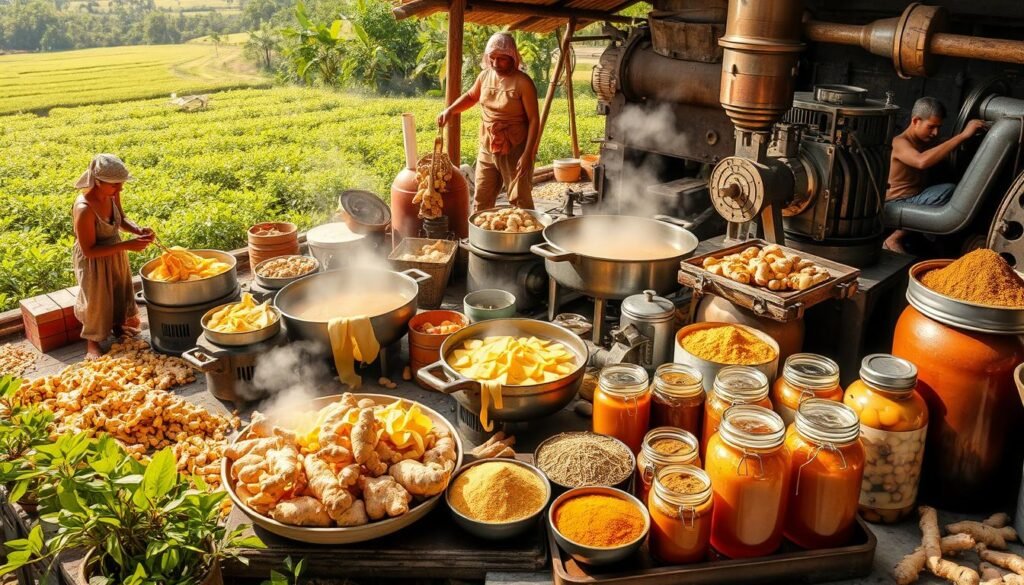
Ginger Peeling and Slicing
Learning how to peel and slice ginger is key. It helps us use every bit of this tasty root and keep its flavour. Peeling ginger right means we waste less and get more out of it.
How to Peel Ginger Correctly
For the best results, use a spoon or vegetable peeler to peel ginger. This way, we get rid of the tough skin but keep the good stuff inside. Young ginger is soft and needs little peeling, while older ginger is tougher and might need more.
Using these tips makes peeling easier and keeps the ginger’s strong taste.
Ginger Slicing Techniques for Consistency
Getting ginger slices the same size is important for cooking and taste. Chefs often use mandolins or sharp knives for this. The way we slice ginger can change how it tastes in a dish.
For teas, thin slices are best because they infuse well. But for stir-fries, thicker slices are better for a hearty bite.
| Usage | Slice Thickness | Slicing Technique |
|---|---|---|
| Tea | Thin | Mandolin |
| Stir-fry | Thick | Sharp Knife |
| Pickling | Medium | Julienne |
| Baking | Ground | Microplane Grater |
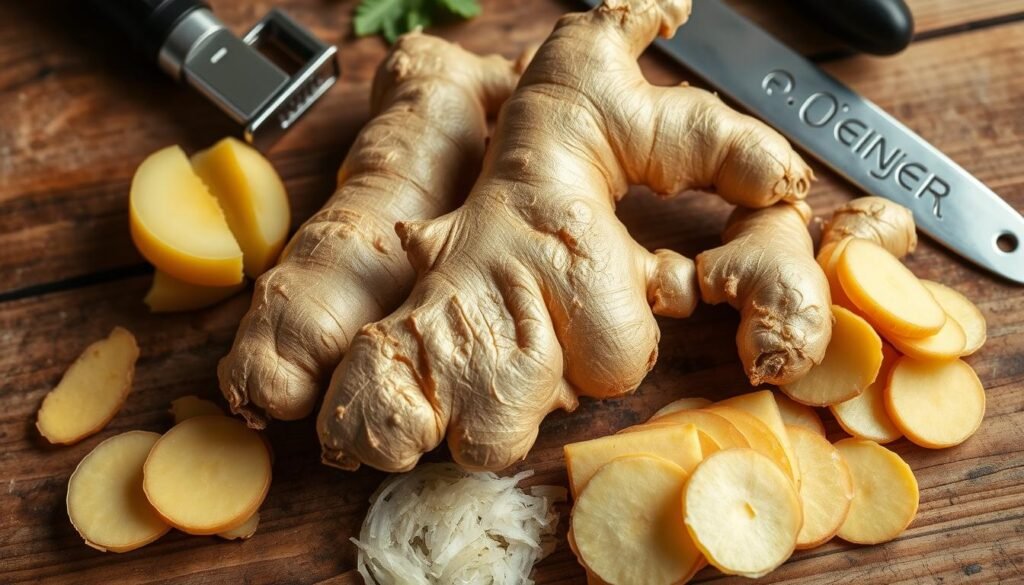
Right slicing not only looks good but also makes our cooking better. By using these methods, we can make our dishes taste better and look great.
Ginger Juice Extraction Methods
Extracting ginger juice is a key step in its production. We look at both old and new ways of doing this. Each method has its own benefits, showing how far we’ve come and the value of tradition.
Traditional versus Modern Extraction Techniques
Traditionally, people grated or pounded ginger to get its juice. This method releases the natural flavours and juices, perfect for cooking. However, it takes a lot of effort and time.
Nowadays, we use machines to extract ginger juice quickly and efficiently. These machines help us get more juice while keeping the flavour and nutrients. They’re key in making ginger juice on a large scale.
Extracting Ginger Juice Efficiently for Production
We aim to extract ginger juice well to make high-quality products. Soaking ginger before juicing can help get more juice out. Using fast juicing tech ensures we get the most juice without losing any good stuff.
It’s important to watch the temperature and pressure when juicing. This helps make the juice better, giving customers a top-notch product. Today’s methods help us meet demand while keeping the juice full of flavour and health benefits.
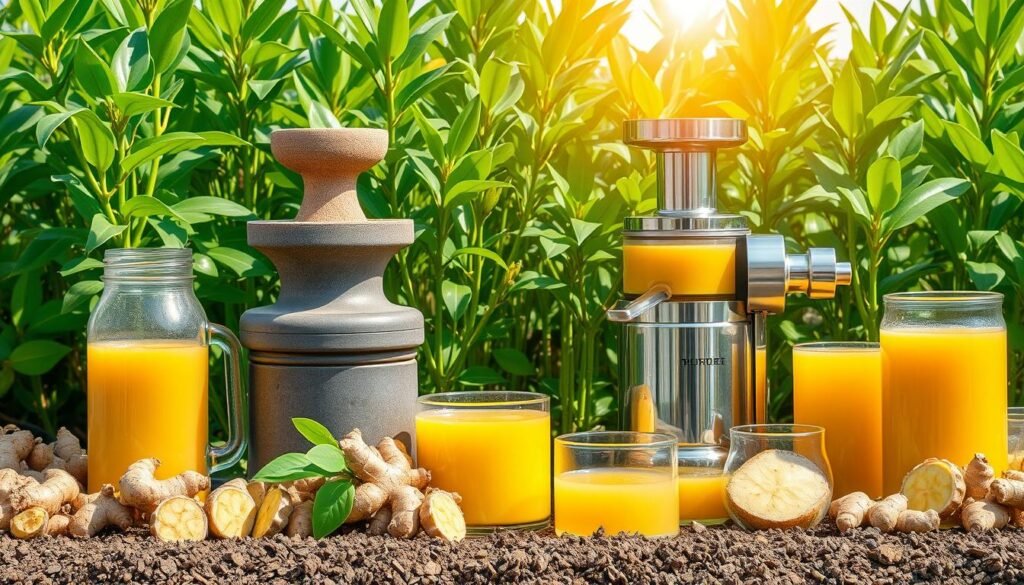
Deep-Processed Ginger Products
Deep-processed ginger products are a big part of the ginger industry. They offer a range of value-added products like candied ginger, ginger paste, and concentrated ginger extracts. These products show how versatile ginger is, meeting different market needs.
Creating these products highlights ginger’s special properties. For example, ginger’s anti-inflammatory and antioxidant qualities are great for health supplements. Deep processing also makes the flavour of ginger better, improving dishes.
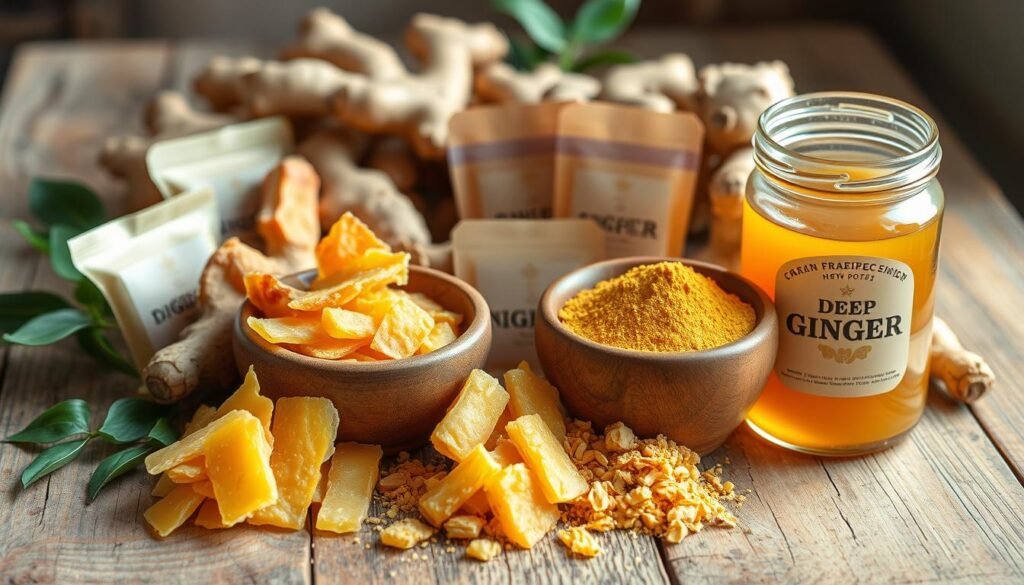
Here’s a table showing some popular deep-processed ginger products and their key features:
| Product | Main Use | Nutritional Benefit | Shelf Life |
|---|---|---|---|
| Candied Ginger | Snacking, Baking | Digestive Aid | 2 Years |
| Ginger Paste | Culinary Ingredient | Anti-inflammatory | 1 Year |
| Concentrated Ginger Extract | Health Supplements | Antioxidant | 3 Years |
These products fit well with the trend of health-conscious and flavourful ingredients. As we keep innovating in ginger processing, we can meet changing tastes and health needs.
Equipment Used in Ginger Processing
In ginger processing, the right equipment is key to quality and efficiency. Choosing the right machinery is crucial for the best results. We’ll look at the essential tools that boost productivity and quality.
Essential Ginger Processing Equipment
The main equipment for ginger processing includes machines for each step, from peeling to juicing. Key items are:
- Ginger Earth Removing Machine: Removes dirt from ginger roots easily.
- Peeling Machines: Mechanised peelers save time and keep quality high.
- Ginger Juicing Machines: Make up to 80% ginger juice, processing 200-400kg/h or 2500-2700kg/h.
- Ginger Dryers: Dry ginger to keep it fresh and quality.
- Filling Machines: Package the ginger juice for sale.
These machines, made from high-quality 304-grade stainless steel, keep the processing area clean and safe.
Innovative Technologies in Ginger Processing
New technologies have changed ginger processing for the better. These advancements improve efficiency and quality. Modern machines now include:
- Hydraulic Pressing Method: Used for ginger juice extraction, removing moisture efficiently.
- Double-Barrel Interchangeable Press Machines: Press and cloth processes together, speeding up production.
- Rotary Vibrating Sieves: Filter out fiber and impurities, making juice pure.
- Homogenisers: Stabilise ginger juice, improving flavour and consistency.
- Degassers: Stop oxidation, keeping ginger juice fresh longer.
Buying advanced ginger processing equipment meets the demand for quality products. It also opens up new market opportunities. These innovations make production smoother and enhance ginger product flavours, meeting consumer tastes.

| Equipment Type | Functionality | Benefits |
|---|---|---|
| Ginger Juicing Machine | Extracts juice with high yields | Up to 80% juice yield, efficient processing |
| Hydraulic Press | Removes moisture with high pressure | Improves extraction efficiency |
| Rotary Vibrating Sieve | Filters ginger fibre and impurities | Ensures quality and purity of juice |
| Degasser | Prevents oxidation | Extends shelf life of ginger juice |
| Filling Machine | Packs end products efficiently | Saves time and labour in distribution |
The Role of Soaking Tanks in Ginger Quality
Soaking tanks for ginger are key to better quality and taste. They come in different types, fitting various needs. Temperature-controlled tanks help with flavour by controlling enzymes. This is important for top-notch ginger.
For smaller operations, basic batch tanks are a cost-effective choice. They soak ginger well, meeting quality standards. The right soaking tank depends on how much you produce and what quality you aim for.
Using soaking tanks boosts flavour and texture. This step is crucial in ginger making.
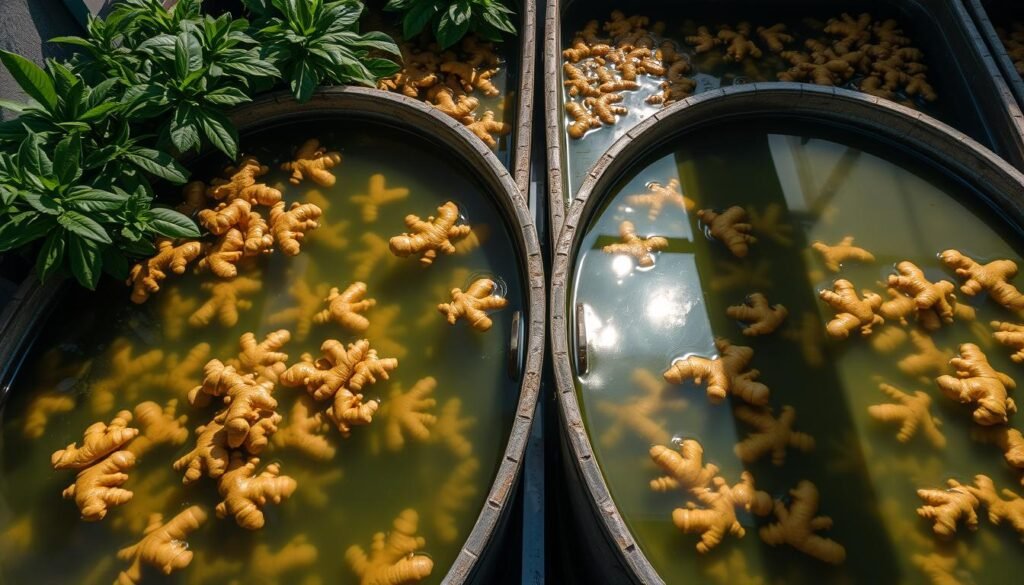
| Type of Soaking Tank | Advantages | Ideal Use Case |
|---|---|---|
| Temperature-Controlled Soaking Tank | Enhances flavour development | Large-scale production with specific quality goals |
| Batch Soaking Tank | Cost-effective for small operations | Small-scale production |
| Combination Soaking Systems | Flexibility in processing | Medium to large-scale production |
Ginger Drying Techniques
Drying ginger is key to keeping its flavour and extending its shelf life. It’s a common method in the industry. We use air drying, food dehydration, and advanced machines to dry ginger well.
Air drying uses the natural environment, but it might not work best in humid places. Food dehydrators are faster, cutting down drying times. Commercial machines control the drying process, keeping flavour and nutrients.
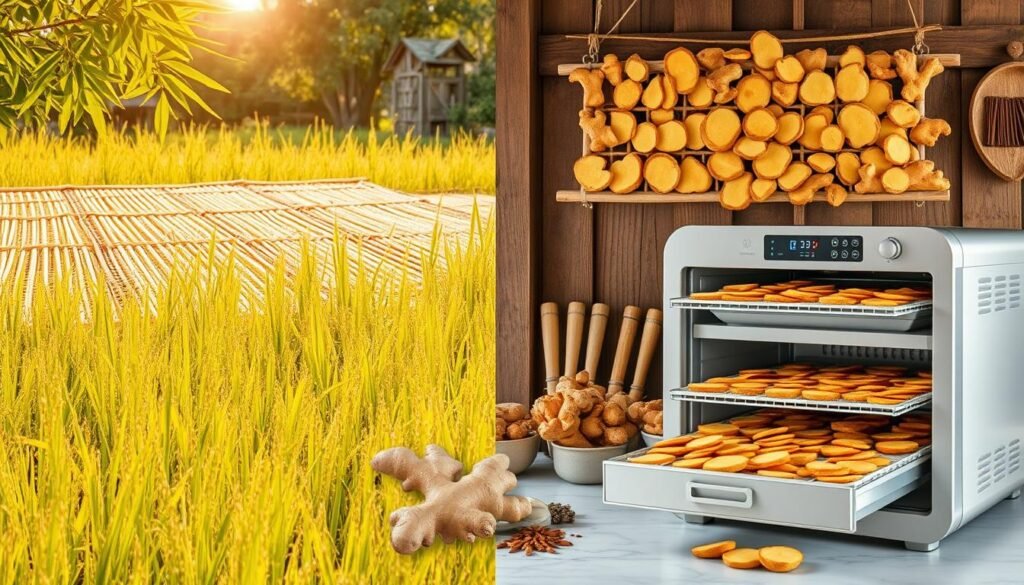
Knowing how much moisture to remove is crucial. Dehydrating ginger removes about 90% of its moisture. This makes it lighter and lasts over a year in airtight containers.
Choosing the right way to prepare ginger is important. Using a mandolin or food processor helps with even drying. Fresh ginger is essential for the best flavour and texture.
Effective drying techniques turn fresh ginger into a versatile ingredient. With growing demand for ginger products, these methods are vital. They help us provide high-quality dried ginger to meet customer needs.
Conclusion
We’ve learned how important it is to know the best ways to process ginger. This keeps the ginger fresh and of high quality. From carefully peeling and slicing to using advanced methods to extract, each step is crucial.
Methods like solvent extraction and supercritical fluid extraction make getting ginger extract better. They also make it safer and better for the environment.
Our summary shows that the choice of method depends on the scale of production and the quality needed. For big-scale production, using modern tools like those from Li An Machinery is key. It ensures the quality stays high.
By focusing on quality, ginger can grow in both food and medicine globally. Our research helps us make top-notch ginger products. This meets the changing needs of people everywhere.
FAQ
What are the primary ginger processing techniques used today?
Today, we mainly use drying, pickling, and juice extraction to process ginger. Each method has its own purpose. They cater to both food and health uses.
How can we effectively peel and slice ginger without losing quality?
To peel ginger well, use a spoon or vegetable peeler. This removes the skin gently. For slicing, a sharp knife or mandolin is best. It helps get even slices for better cooking and taste.
What modern equipment is most effective for ginger juice extraction?
Modern juice extractors are top for getting ginger juice. They boost yield and keep nutrients better than old ways. This is because they work faster and more efficiently.
How does the processing method impact the quality of ginger products?
The way ginger is processed greatly affects its quality and taste. Bad methods can spoil it or reduce its strength. But, modern techniques help keep the taste and nutrients better.
What are the benefits of deep-processing ginger?
Deep-processing ginger lets us make products like ginger paste and candied ginger. It also makes concentrated extracts. This opens up new uses in cooking and boosts market chances.
What role do soaking tanks play in enhancing ginger quality?
Soaking tanks are key in improving ginger quality. They control enzymes and enhance flavour. This makes them a crucial part of ginger processing.
What are the best practices for drying ginger effectively?
Good ginger drying uses air drying, food dehydrators, or commercial machines. These methods create a controlled environment. They help remove moisture well while keeping taste and nutrients.
Source Links
- PDF – https://ijsred.com/volume6/issue6/IJSRED-V6I6P78.pdf
- Ginger processing(FROM FIELD TO FORK) – https://www.slideshare.net/slideshow/ginger-processingfrom-field-to-fork/152044212
- Increasing Ginger Juice Extraction with PEF Technology – OptiCept Technologies – https://www.opticept.se/increasing-ginger-juice-extraction-with-pef-technology/
- Ginger Juice – Healthier Steps – https://healthiersteps.com/ginger-juice/
- 11 Scientifically Proven Health Benefits of Ginger – https://www.healthline.com/nutrition/11-proven-benefits-of-ginger
- Ginger | alchemyacademy.world – https://alchemyacademy.world/ginger/
- How to Make Ginger Powder (Two Methods) – https://www.alphafoodie.com/how-to-make-ginger-powder-two-methods/
- Why Do You Need to Peel Ginger Before Juicing: Answers – Deliciously Rushed – https://deliciouslyrushed.com/why-do-you-need-to-peel-ginger-before-juicing-answers/
- PDF – https://www.ijcmas.com/7-4-2018/Bijaya B. Bag, et al.pdf
- 14 Tips You Need For Cooking With Ginger – Tasting Table – https://www.tastingtable.com/1061468/tips-you-need-for-cooking-with-ginger/
- How to Peel, Slice, Julienne, Chop, Mince, and Grate Ginger – https://www.simplyrecipes.com/recipes/how_to_peel_and_chop_ginger/
- Ginger Juice + Ginger Shots – https://willamettetransplant.com/ginger-juice/
- Homemade Ginger Juice (without a juicer) – https://thedizzycook.com/how-to-make-ginger-juice/
- Design and development of a multi-tasks motorized ginger rhizomes juice expression machine – https://www.academia.edu/91720807/Design_and_development_of_a_multi_tasks_motorized_ginger_rhizomes_juice_expression_machine
- CN102845754A – Ginger extract and preparation method thereof – https://patents.google.com/patent/CN102845754A/en
- Design, development and statistical optimization of ginger peeling machine – https://www.academia.edu/118889260/Design_development_and_statistical_optimization_of_ginger_peeling_machine
- PDF – https://ijeab.com/upload_document/issue_files/50 IJEAB-FEB-2017-2-Postharvest Management and Value Addition of Ginger.pdf
- Development of a ginger product to add value to the Fijian ginger industry – https://phamaplus.com.au/wp-content/uploads/2024/07/TR110-Development-of-a-ginger-product-to-add-value-to-the-Fiji-ginger-industry.pdf
- How To Juice Ginger With and Without Juicer – https://www.alphafoodie.com/how-to-juice-ginger-with-and-without-juicer/
- How To: Dehydrate Ginger + Make Ginger Powder – Crave The Good – https://www.cravethegood.com/how-to-dehydrate-ginger/
- The best method for extracting ginger extract. – https://www.greenskybio.com/blog4/the-best-method-for-extracting-ginger-extract.html
- Physicochemical Evaluation of Coated Ginger during Long-Term Storage: Impact of Chitosan and Beeswax Bilayer Coatings at Different Temperatures – https://pmc.ncbi.nlm.nih.gov/articles/PMC11161266/
- Performance Evaluation of a Portable Ginger Slicing Machine – https://www.academia.edu/94825639/Performance_Evaluation_of_a_Portable_Ginger_Slicing_Machine?uc-g-sw=34981964

